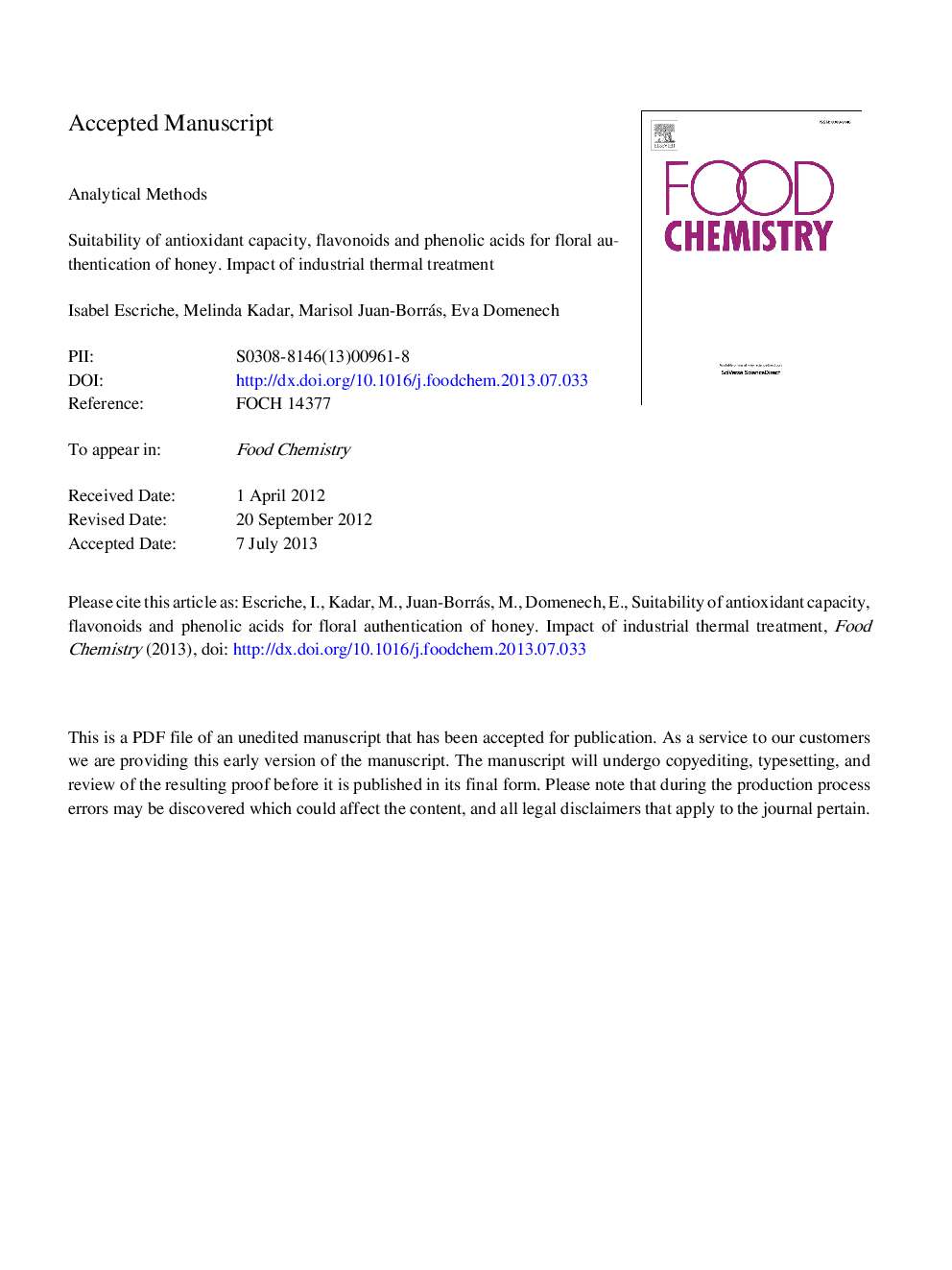| کد مقاله | کد نشریه | سال انتشار | مقاله انگلیسی | نسخه تمام متن |
|---|---|---|---|---|
| 7601264 | 1492149 | 2014 | 34 صفحه PDF | دانلود رایگان |
عنوان انگلیسی مقاله ISI
Suitability of antioxidant capacity, flavonoids and phenolic acids for floral authentication of honey. Impact of industrial thermal treatment
ترجمه فارسی عنوان
مناسب بودن ظرفیت آنتی اکسیدان، فلاونوئیدها و اسید های فنولی برای تأیید صحت عسل عسل. تاثیر درمان حرارتی صنعتی
دانلود مقاله + سفارش ترجمه
دانلود مقاله ISI انگلیسی
رایگان برای ایرانیان
کلمات کلیدی
عسل، فلاونوئیدها، اسید فنولیک، ظرفیت آنتی اکسیدان، احراز هویت،
ترجمه چکیده
فعالیت کل آنتی اکسیدانی، پارامترهای فیزیکی و شیمیایی و مشخصات فلاونوئیدها و ترکیبات اسید فنولیک برای توانایی آنها در تشخیص بین ریشه های گیاهی چهار نوع عسل اسپانیایی، تاثیر درمان حرارتی صنعتی و اثر سال جمع آوری . عسل مرکبات دارای کمترین سطوح تمام متغیرهای مورد تجزیه و تحلیل بوده و سپس رزماری و پلیفلور و بالاترین آن عسل است. منشاء گیاه شناسی بر روی پروفایل فلاونوئیدها و ترکیبات فنلی تاثیر می گذارد به طوری که به دلیل تبعیض به دلیل غلبه بر ترکیبات خاص مانند: هسپرتین (در عسل مرکبات) به طرق مختلف اجازه می دهد؛ کامففرل، کریسین، پینکامبرین، اسید کافئیک و نیرینگینین (عسل رزماری) و میریستین، کورستین، گالنگین و به ویژه اسید پکوکوراریک (در عسل عسل). تاثیر تیمارهای حرارتی صنعتی کمتر از تغییرات مورد انتظار در نتیجه سال جمعآوری است، هرچند این فاکتور تاثیر کافی برای تغییر این ترکیبات مؤثری نداشته و تاثیر منفی بر تبعیض عسل از طریق گیاه شناسی دارد.
موضوعات مرتبط
مهندسی و علوم پایه
شیمی
شیمی آنالیزی یا شیمی تجزیه
چکیده انگلیسی
Total antioxidant activity, physicochemical parameters, and the profile of flavonoids and phenolic acid compounds were evaluated for: their ability to distinguish between the botanical origins of four types of Spanish honey, the impact of industrial thermal treatment, and the effect of the year of collection. Citrus honey had the lowest levels of all the analysed variables, then rosemary and polyfloral, and honeydew the highest ones. Botanical origin affects the profile of flavonoids and phenolic compounds sufficiently to permit discrimination thanks to the predominance of particular compounds such as: hesperetin (in citrus honey); kaempferol, chrysin, pinocembrin, caffeic acid and naringenin (in rosemary honey) and myricetin, quercetin, galangin and particularly p-coumaric acid (in honeydew honey). The impact of industrial thermal treatments is lower than the expected variability as a consequence of the year of collection, though neither factor has enough influence to alter these constituent compounds to the point of affecting the discrimination of honey by botanical origin.
ناشر
Database: Elsevier - ScienceDirect (ساینس دایرکت)
Journal: Food Chemistry - Volume 142, 1 January 2014, Pages 135-143
Journal: Food Chemistry - Volume 142, 1 January 2014, Pages 135-143
نویسندگان
Isabel Escriche, Melinda Kadar, Marisol Juan-Borrás, Eva Domenech,
